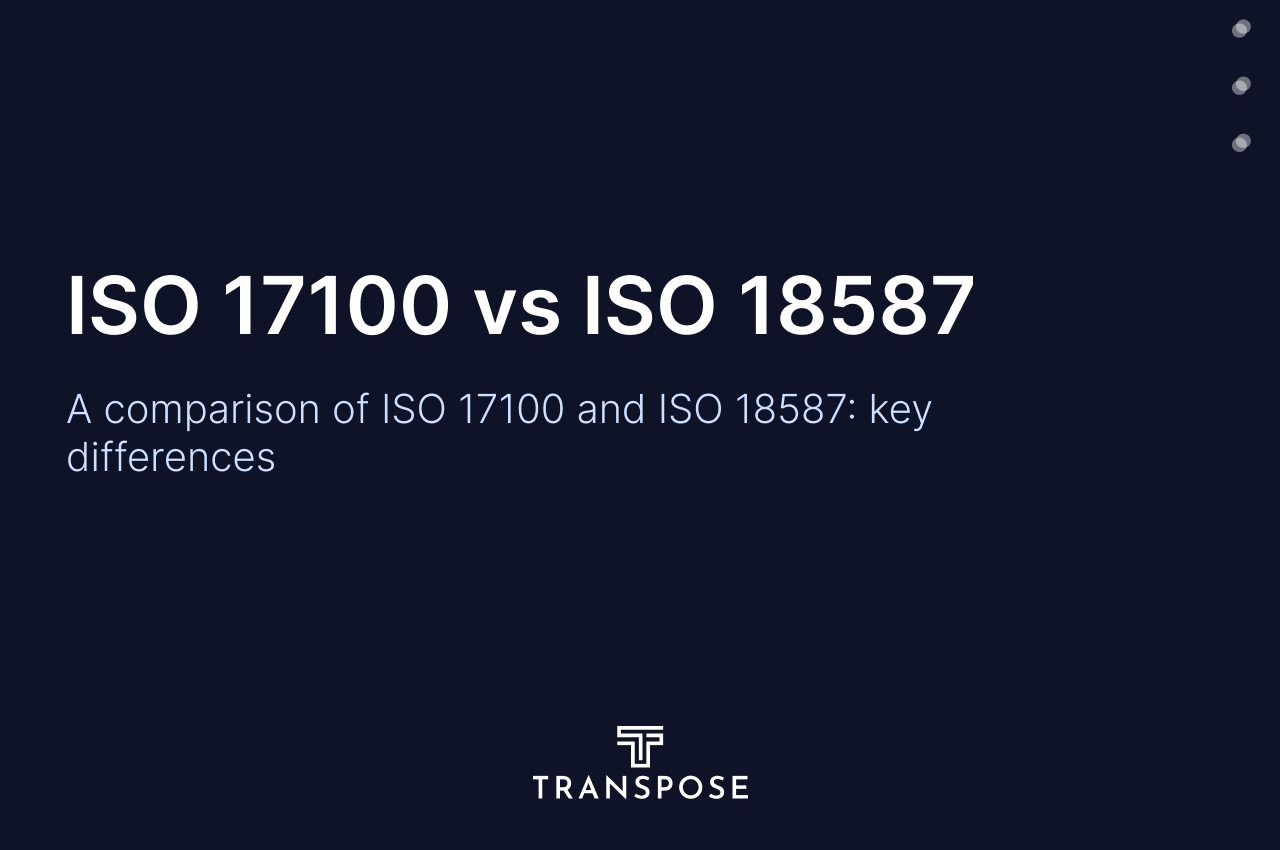Translation quality standards aren't just bureaucratic hoops—they're business lifesavers.
Understanding the difference between ISO 17100 and ISO 18587 is essential for choosing the right translation services that align with your specific needs and quality expectations.
The Importance of ISO Standards in Translation Services
ISO translation standards serve as the gold standard for translation service providers (TSPs) worldwide. Think of them as the recipe that ensures your message doesn't get lost in translation. These standards establish clear processes, required competencies, and quality control mechanisms that help deliver consistent, accurate translations across languages and cultures.
The International Organization for Standardization developed these standards as a response to the growing pains of global business communication—addressing the need for reliability and consistency when words cross borders. Without these guardrails, multilingual communication becomes a risky proposition, especially for businesses where precision matters.
When a translation provider waves their certification credentials, they're essentially saying, "We've had independent experts verify we know what we're doing." For clients, this third-party validation offers peace of mind that your translation projects won't be handled by amateurs using Google Translate. Certified providers have proven they follow structured processes designed specifically to deliver quality translations consistently.
What is ISO 17100 Certification?
ISO 17100 certification is an international standard for translation services. It sets requirements for processes, resources, and quality to ensure accurate and professional translations. Certified providers follow strict guidelines for translator qualifications, project management, and quality control.
ISO 17100:2015 has become the global gold standard for professional translation services, replacing the earlier European standard EN 15038. It's comprehensive, covering everything from who can translate your documents to how they should be reviewed and delivered.
Core Requirements and Framework
At its heart, the framework of ISO 17100 is built on a simple but powerful principle: the two-person approach. Every translation must be handled by a qualified translator and then reviewed by a separate qualified reviewer. This human-centered methodology ensures that cultural nuances, industry-specific terminology, and contextual subtleties aren't lost—something machines still struggle with despite impressive advances.
Key Areas of ISO 17100:2015
Resources and Human Competency Requirements
The ISO 17100 standard sets specific competency requirements that translators must meet—either through formal translation degrees, other relevant degrees plus experience, or documented professional experience. This ensures consistent quality levels by verifying that the people handling your content actually know what they're doing.
Pre-Production Processes
Before anyone types a single translated word, ISO 17100 requires clear processes for project preparation. This includes detailed agreements between clients and providers, proper project registration, and thoughtful resource assignment. It's like measuring twice before cutting once—proper preparation prevents poor performance.
Production Workflow Management
The translation workflow under ISO 17100 mandates a structured approach with multiple checkpoints throughout the translation process. The translator translates, checks their own work, then a separate linguist reviews everything. This multi-layered approach catches issues that might slip through with a single-person process.
Post-Production Validation
Great translation providers don't just deliver and disappear. ISO 17100 requires systematic feedback collection and proper project closure procedures. This quality assurance approach creates a cycle of continuous improvement where each project helps refine processes for future work.
What is ISO 18587 Certification
ISO 18587 certification is an international standard for post-editing machine-translated content. It sets guidelines for using professional human editors to improve the quality of machine translations. The goal is to ensure the final text meets the same standards as human translation.
As AI and machine translation technologies transform the industry, ISO 18587:2017 has emerged to address the unique challenges of working with machine translation output. This standard focuses specifically on how human linguists should review and refine machine-generated translations.
📖 You might also like to read: Common Mistakes ChatGPT Can Make During Translations
Focus on Post-Editing Machine Translation Output
While ISO 17100 is all about human translation from start to finish, ISO 18587 acknowledges that machine translation is here to stay—and provides a framework for effectively combining technological efficiency with human expertise. It establishes clear requirements for the post-editing process to ensure machine translations are properly refined by qualified linguists.
Key Areas of ISO 18587:2017
Post-Editing Process Requirements
Not all content needs the same level of post-editing. ISO 18587 defines two distinct approaches: light post-editing (making the text understandable but not necessarily perfect) and full post-editing (bringing the text up to human translation quality). This distinction helps organizations balance quality needs with budget constraints.
Post-Editor Competencies
Post-editing isn't just regular translation. ISO 18587 recognizes this by specifying the unique competency requirements for post-editors, including linguistic expertise, cultural knowledge, and technical skills with post-editing tools. Post-editors need to quickly identify machine translation patterns and efficiently correct them—a specialized skill set.
Quality Criteria for Machine Translation
The standard establishes specific quality criteria for machine-translated content, addressing common issues like terminology inconsistency and syntactic errors. These criteria provide a structured approach for evaluating and improving machine-generated content—essential as organizations increasingly incorporate AI into their translation workflows.
📖 You might also like to read: Common Mistakes ChatGPT Can Make During Translations
Comparing ISO 17100 vs ISO 18587: Key Differences
Scope and Focus Differences
The fundamental difference? ISO 17100 covers traditional human translation workflows from start to finish, while ISO 18587 specifically addresses post-editing of machine translation output. One takes a comprehensive view of the entire translation process; the other focuses narrowly on effectively improving machine-generated content.
Human Translation vs Machine Translation Approaches
ISO 17100 puts humans in the driver's seat throughout the entire process. ISO 18587, meanwhile, acknowledges the growing role of technology and provides a framework for effectively combining machine efficiency with human refinement. It's not about which approach is better—they serve different purposes and can complement each other beautifully.
Resource Requirements for Each Standard
From a practical standpoint, ISO 17100 typically requires more extensive human resources, with qualified translators and separate revisers for each project. ISO 18587 can potentially reduce resource requirements by leveraging machine translation for the heavy lifting, with human experts focusing on refinement rather than translation from scratch.
